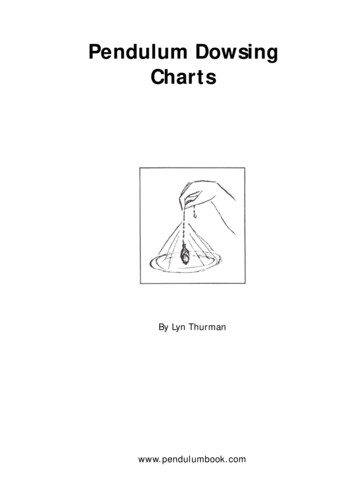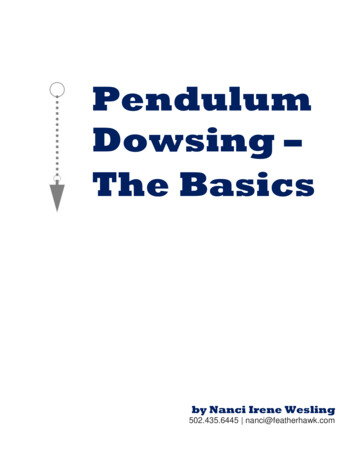
Transcription
Chapter 24 Physical Pendulum24.1 Introduction . 124.1.1 Simple Pendulum: Torque Approach . 124.2 Physical Pendulum . 224.3 Worked Examples . 4Example 24.1 Oscillating Rod . 4Example 24.3 Torsional Oscillator . 7Example 24.4 Compound Physical Pendulum. 9Appendix 24A Higher-Order Corrections to the Period for Larger Amplitudes ofa Simple Pendulum . 12
Chapter 24 Physical Pendulum . I had along with me .the Descriptions, with some Drawings of theprincipal Parts of the Pendulum-Clock which I had made, and as also ofthem of my then intended Timekeeper for the Longitude at Sea.1John Harrison24.1 IntroductionWe have already used Newton’s Second Law or Conservation of Energy to analyzesystems like the spring-object system that oscillate. We shall now use torque and therotational equation of motion to study oscillating systems like pendulums and torsionalsprings.24.1.1 Simple Pendulum: Torque ApproachRecall the simple pendulum from Chapter 23.3.1.The coordinate system and forcediagram for the simple pendulum is shown in Figure 24.1.(a)(b)Figure 24.1 (a) Coordinate system and (b) torque diagram for simple pendulumThe torque about the pivot point P is given by τ P rP, m m g l r̂ m g(cosθ r̂ sin θ θ̂) l m g sin θ k̂(24.1.1)The z -component of the torque about point P(τ P ) z mgl sin θ .(24.1.2)1J. Harrison, A Description Concerning Such Mechanisms as will Afford a Nice, or True Mensuration ofTime; (London, 1775), p.19.24-1
When θ 0 , (τ P ) z 0 and the torque about P is directed in the negative k̂ -direction(into the plane of Figure 24.1b) when θ 0 ,(τ P ) z 0 and the torque about P isdirected in the positive k̂ -direction (out of the plane of Figure 24.1b). The moment ofinertia of a point mass about the pivot point P is I P ml 2 . The rotational equation ofmotion is thenThus we haved 2θ(τ P ) z I Pα z I P 2dtd 2θ mgl sin θ ml 2 2 .dt(24.1.3)d 2θg sin θ ,2dtl(24.1.4)agreeing with Eq. 23. 3.14. When the angle of oscillation is small, we may use the smallangle approximation(24.1.5)sin θ θ ,and Eq. (24.1.4) reduces to the simple harmonic oscillator equationd 2θg θ .2dtl(24.1.6)We have already studied the solutions to this equation in Chapter 23.3. A procedure fordetermining the period when the small angle approximation does not hold is given inAppendix 24A.24.2 Physical PendulumA physical pendulum consists of a rigid body that undergoes fixed axis rotation about afixed point S (Figure 24.2).Figure 24.2 Physical pendulum24-2
The gravitational force acts at the center of mass of the physical pendulum. Denote thedistance of the center of mass to the pivot point S by lcm . The torque analysis is nearlyidentical to the simple pendulum. The torque about the pivot point S is given by τ S rS , cm m g lcm r̂ m g(cosθ r̂ sin θ θ̂) lcm m g sin θ k̂ .(24.2.1)Following the same steps that led from Equation (24.1.1) to Equation (24.1.4), therotational equation for the physical pendulum isd 2θ mglcm sin θ I S 2 ,dt(24.2.2)where I S the moment of inertia about the pivot point S . As with the simple pendulum,for small angles sin θ θ , Equation (24.2.2) reduces to the simple harmonic oscillatorequationmglcmd 2θ(24.2.3) θ.2ISdtThe equation for the angle θ (t) is given byθ (t) A cos(ω 0 t) Bsin(ω 0 t) ,(24.2.4)where the angular frequency is given byω0 mg lcmIS(physical pendulum) ,(24.2.5)and the period isT IS2π 2πω0mg lcm(physical pendulum) .(24.2.6)2Substitute the parallel axis theorem, I S mlcm I cm , into Eq. (24.2.6) with the result thatT 2πlcmI cmg mg lcm(physical pendulum) .(24.2.7)2Thus, if the object is “small” in the sense that I cm mlcm, the expressions for thephysical pendulum reduce to those for the simple pendulum. The z -component of theangular velocity is given by24-3
ω z (t) dθ(t) ω 0 Asin(ω 0 t) ω 0 Bcos(ω 0 t) .dt(24.2.8)The coefficients A and B can be determined form the initial conditions by setting t 0in Eqs. (24.2.4) and (24.2.8) resulting in the conditions thatA θ (t 0) θ 0B ω z (t 0) ω z,0 .ω0ω0Therefore the equations for the angle θ (t) and ω z (t) θ (t) θ 0 cos(ω 0 t) ω z (t) ω z,0ω0(24.2.9)dθ(t) are given bydtsin(ω 0 t) ,dθ(t) ω 0θ 0 sin(ω 0 t) ω z,0 cos(ω 0 t) .dt(24.2.10)(24.2.11)24.3 Worked ExamplesExample 24.1 Oscillating RodA physical pendulum consists of a uniform rod of length d and mass m pivoted at oneend. The pendulum is initially displaced to one side by a small angle θ 0 and releasedfrom rest with θ 0 1 . Find the period of the pendulum. Determine the period of thependulum using (a) the torque method and (b) the energy method.Figure 24.3 Oscillating rod(a) Torque Method: with our choice of rotational coordinate system the angularacceleration is given by24-4
d 2θα 2 k̂ .dt(24.3.1)The force diagram on the pendulum is shown in Figure 24.4. In particular, there is anunknown pivot force and the gravitational force acts at the center of mass of the rod.Figure 24.4 Free-body force diagram on rodThe torque about the pivot point P is given by τ P rP,cm mg .(24.3.2)The rod is uniform, therefore the center of mass is a distance d / 2 from the pivot point.The gravitational force acts at the center of mass, so the torque about the pivot point P isgiven by (24.3.3)τ P (d / 2)r̂ mg( sin θ θ̂ cos r̂) (d / 2)mg sin θ k̂ .The rotational equation of motion about P is then τ P I Pα .(24.3.4)Substituting Eqs. (24.3.3) and (24.3.1) into Eq. (24.3.4) yieldsd 2θ (d / 2)mg sin θ k̂ I P 2 k̂ .dt(24.3.5)When the angle of oscillation is small, we may use the small angle approximationsin θ θ , then Eq. (24.3.5) becomes24-5
d 2θ (d / 2)mg θ 0,IPdt 2(24.3.6)which is a simple harmonic oscillator equation. The angular frequency of smalloscillations for the pendulum is(d / 2)mg.(24.3.7)ω0 IPThe moment of inertia of a rod about the end point P is I P (1 / 3)md 2 therefore theangular frequency is(d / 2)mg(3 / 2)g(24.3.8)ω0 2d(1/ 3)mdwith periodT 2π2d. 2πω03g(24.3.9)(b) Energy Method: Take the zero point of gravitational potential energy to be the pointwhere the center of mass of the pendulum is at its lowest point (Figure 24.5), that is,θ 0.Figure 24.5 Energy diagram for rodWhen the pendulum is at an angle θ the potential energy isdU m g (1 cosθ ) .2(24.3.10)The kinetic energy of rotation about the pivot point is24-6
K rot 1I pω z 2 .2(24.3.11)The mechanical energy is thenE U K rot m gd11 cosθ ) I pω z 2 ,(22(24.3.12)with I P (1/ 3)md 2 . There are no non-conservative forces acting (by assumption), so themechanical energy is constant, and therefore the time derivative of energy is zero,0 dω zdEddθ m g sinθ I pω z.dt2dtdt(24.3.13)Recall that ω z dθ / dt and α z dω z / dt d 2θ / dt 2 , so Eq. (24.3.13) becomes dd 2θ 0 ω z m g sin θ I p 2 .2dt (24.3.14)There are two solutions, ω z 0 , in which case the rod remains at the bottom of theswing,dd 2θ0 m g sin θ I p 2 .(24.3.15)2dtUsing the small angle approximation, we obtain the simple harmonic oscillator equation(Eq. (24.3.6))d 2θ m g(d / 2) θ 0.(24.3.16)Ipdt 2Example 24.3 Torsional OscillatorA disk with moment of inertia about the center of mass I cm rotates in a horizontal plane.It is suspended by a thin, massless rod. If the disk is rotated away from its equilibriumposition by an angle θ , the rod exerts a restoring torque about the center of the disk withmagnitude given by τ cm b θ (Figure 24.6), where b is a positive constant. At t 0 , thedisk is released from rest at an angular displacement of θ 0 . Find the subsequent timedependence of the angular displacement θ (t ) .24-7
Figure 24.6 Example 24.3 with exaggerated angle θSolution: Choose a coordinate system such that k̂ is pointing upwards (Figure 24.6),then the angular acceleration is given by d 2θα 2 k̂ .(24.3.17)dtThe torque about the center of mass is given in the statement of the problem as arestoring torque, therefore (24.3.18)τ cm b θ k̂ .The z -component of the rotational equation of motion is b θ I cmd 2θ.dt 2(24.3.19)This is a simple harmonic oscillator equation with solutionθ (t) Acos(ω 0 t) Bsin(ω 0 t)(24.3.20)where the angular frequency of oscillation is given byω 0 b / I cm .(24.3.21)The z -component of the angular velocity is given byω z (t) dθ(t) ω 0 Asin(ω 0 t) ω 0 Bcos(ω 0 t) .dt(24.3.22)The initial conditions at t 0 , are θ (t 0) A θ 0 , and (dθ / dt)(t 0) ω 0 B 0 .Thereforeθ (t) θ 0 cos( b / I cm t) .(24.3.23)24-8
Example 24.4 Compound Physical PendulumA compound physical pendulum consists of a disk of radius R and mass md fixed at theend of a rod of mass mr and length l (Figure 24.7a). (a) Find the period of the pendulum.(b) How does the period change if the disk is mounted to the rod by a frictionless bearingso that it is perfectly free to spin?(a)Figure 24.7 (a) Example 24.4(b)(b) Free-body force diagramSolution: We begin by choosing coordinates. Let k̂ be normal to the plane of the motionof the pendulum pointing out of the plane of the Figure 24.7b. Choose an angle variableθ such that counterclockwise rotation corresponds to a positive z -component of theangular velocity. Thus a torque that points into the page has a negative z -component anda torque that points out of the page has a positive z -component. The free-body forcediagram on the pendulum is also shown in Figure 24.7b. In particular, there is anunknown pivot force, the gravitational force acting at the center of mass of the rod, andthe gravitational force acting at the center of mass of the disk. The torque about the pivotpoint is given by τ P rP,cm mr g rP,disk md g .(24.3.24) Recall that the vector rP,cm points from the pivot point to the center of mass of the rod a distance l / 2 from the pivot. The vector rP,disk points from the pivot point to the center ofmass of the disk a distance l from the pivot. Torque diagrams for the gravitational forceon the rod and the disk are shown in Figure 24.8. Both torques about the pivot are in thenegative k̂ -direction (into the plane of Figure 24.8) and hence have negative z components, (24.3.25)τ P (mr (l / 2) md l)g sin θ k̂ .24-9
(a)(b)Figure 24.8 Torque diagram for (a) center of mass, (b) diskIn order to determine the moment of inertia of the rigid compound pendulum we willtreat each piece separately, the uniform rod of length d and the disk attached at the endof the rod. The moment of inertia about the pivot point P is the sum of the moments ofinertia of the two pieces,I P I P,rod I P,disc .(24.3.26)We calculated the moment of inertia of a rod about the end point P (Chapter 16.3.3),with the result that1I P,rod mr l 2 .(24.3.27)3We can use the parallel axis theorem to calculate the moment of inertia of the disk aboutthe pivot point P ,I P,disc I cm,disc md l 2 .(24.3.28)We calculated the moment of inertia of a disk about the center of mass (Example 16.3)and determined that1I cm,disc md R 2 .(24.3.29)2The moment of inertia of the compound system is then11I P mr l 2 md l 2 md R 2 .32(24.3.30)Therefore the rotational equation of motion becomes24-10
( ((1/ 2)mr md )gl sin θ k̂ ((1/ 3)mr md )l 2 (1/ 2)md R 2)d 2θk̂ . (24.3.31)dt 2When the angle of oscillation is small, we can use the small angle approximationsin θ θ . Then Eq. (24.3.31) becomes a simple harmonic oscillator equation,((1/ 2)mr md )gld 2θ θ.2dt((1/ 3)mr md )l 2 (1/ 2)md R 2(24.3.32)Eq. (24.3.32) describes simple harmonic motion with an angular frequency of oscillationwhen the disk is fixed in place given byω fixed ((1/ 2)mr md )gl.((1/ 3)mr md )l 2 (1/ 2)md R 2(24.3.33)The period isTfixed((1/ 3)mr md )l 2 (1/ 2)md R 22π. 2πω fixed((1/ 2)mr md )gl(24.3.34)(b) If the disk is not fixed to the rod, then it will not rotate about its center of mass as thependulum oscillates. Therefore the moment of inertia of the disk about its center of massdoes not contribute to the moment of inertia of the physical pendulum about the pivotpoint. Notice that the pendulum is no longer a rigid body. The total moment of inertia isonly due to the rod and the disk treated as a point like object,1I P mr l 2 md l 2 .3(24.3.35)Therefore the period of oscillation is given byTfree((1/ 3)mr md )l 22π. 2πω free((1/ 2)mr md )gl(24.3.36)Comparing Eq. (24.3.36) to Eq. (24.3.34), we see that the period is smaller when the diskis free and not fixed. From an energy perspective we can argue that when the disk is free,it is not rotating about the center of mass. Therefore more of the gravitational potentialenergy goes into the center of mass translational kinetic energy than when the disk is free.Hence the center of mass is moving faster when the disk is free so it completes oneperiod is a shorter time.24-11
Appendix 24A Higher-Order Corrections to the Period for LargerAmplitudes of a Simple PendulumIn Section 24.1.1, we found the period for a simple pendulum that undergoes smalloscillations is given byT 2πl 2πω0g(simple pendulum) .How good is this approximation? If the pendulum is pulled out to an initial angle θ 0 thatis not small (such that our first approximation sin θ θ no longer holds) then ourexpression for the period is no longer valid. We shall calculate the first-order (or higherorder) correction to the period of the pendulum.Let’s first consider the mechanical energy, a conserved quantity in this system. Choosean initial state when the pendulum is released from rest at an angle θ i ; this need not be attime t 0 , and in fact later in this derivation we’ll see that it’s inconvenient to choosethis position to be at t 0 . Choose for the final state the position and velocity of the bobat an arbitrary time t . Choose the zero point for the potential energy to be at the bottomof the bob’s swing (Figure 24A.1).Figure 24A.1 Energy diagram for simple pendulumThe mechanical energy when the bob is released from rest at an angle θ i isEi K i U i m g l (1 cosθ i ) .(24.C.37)The tangential component of the velocity of the bob at an arbitrary time t is given byvθ ldθ,dt(24.C.38)and the kinetic energy at that time is24-12
211 dθ K f mvθ 2 m l .22 dt (24.C.39)The mechanical energy at time t is then21 dθ Ef K f U f m l m g l (1 cos θ ) .2 dt (24.C.40)Because the tension in the string is always perpendicular to the displacement of the bob,the tension does no work, we neglect any frictional forces, and hence mechanical energyis constant, E f Ei . Thus21 dθ m l m g l (1 cosθ ) m g l (1 cosθ i )2 dt 2 dθ g l dt 2 l (cosθ cosθ i ).(24.C.41)We can solve Equation (24.C.41) for the angular velocity as a function of θ ,dθ2g cosθ cosθ i .dtl(24.C.42)Note that we have taken the positive square root, implying that dθ / dt 0 . This clearlycannot always be the case, and we should change the sign of the square root every timethe pendulum’s direction of motion changes. For our purposes, this is not an issue. If wewished to find an explicit form for either θ (t) or t (θ ) , we would have to consider thesigns in Equation (24.C.42) more carefully.Before proceeding, it’s worth considering the difference between Equation (24.C.42) andthe equation for the simple pendulum in the simple harmonic oscillator limit, wherecosθ 1 (1/ 2)θ 2 . Then Eq. (24.C.42) reduces to2dθ2g θ i θ 2. dtl22(24.C.43)In both Equations (24.C.42) and (24.C.43) the last term in the square root is proportionalto the difference between the initial potential energy and the final potential energy. Thefinal potential energy for the two cases is plotted in Figures 24A.2 for π θ π on theleft and π / 2 θ π / 2 on the right (the vertical scale is in units of mgl ).24-13
Figures 24A.2 Potential energies as a function of displacement angleIt would seem to be to our advantage to express the potential energy for an arbitrarydisplacement of the pendulum as the difference between two squares. We do this by firstrecalling the trigonometric identity1 cosθ 2sin 2 (θ / 2)(24.C.44)with the result that Equation (24.C.42) may be re-expressed asdθ2g 2(sin 2 (θ i / 2) sin 2 (θ / 2)) .dtl(24.C.45)Equation (24.C.45) is separable,dθsin 2 (θ i / 2) sin 2 (θ / 2) 2gdtl(24.C.46) 2gdt .l(24.C.47)Rewrite Equation (24.C.46) asdθsin 2 (θ / 2)sin(θ i / 2) 1 2sin (θ i / 2)The ratio sin(θ / 2) / sin(θ i / 2) in the square root in the denominator will oscillate (butnot with simple harmonic motion) between 1 and 1 , and so we will make theidentificationsin(θ / 2).(24.C.48)sin φ sin(θ i / 2)24-14
Let b sin(θ i / 2) , so thatsinθ bsin φ2θ θ cos 1 sin 2 2 2 (24.C.49)12 (1 b2 sin 2 φ )1 2 .Eq. (24.C.47) can then be rewritten in integral form as bdθ1 sin φ2 2 gdt .l(24.C.50)From differentiating the first expression in Equation (24.C.49), we have that1θcos dθ bcosφ dφ22dθ 2b 2b1 sin 2 φcosφdφ 2bdφcos(θ / 2)1 sin 2 (θ / 2)1 sin 2 φ1 b2 sin 2 φ(24.C.51)dφ .Substituting the last equation in (24.C.51) into the left-hand side of the integral in(24.C.50) yields b1 sin 2 φ2b1 sin 2 φ 1 b2 sin 2 φdφ 2 dφ1 b2 sin 2 φ.(24.C.52)Thus the integral in Equation (24.C.50) becomes dφ1 b2 sin 2 φ gdt .l(24.C.53)This integral is one of a class of integrals known as elliptic integrals. We find a powerseries solution to this integral by expanding the function13(1 b2 sin 2 φ ) 1 2 1 b2 sin 2 φ b4 sin 4 φ .28(24.C.54)The integral in Equation (24.C.53) then becomes24-15
1 1 2 b2 3gsin 2 φ b4 sin 4 φ dφ dt .8l (24.C.55)Now let’s integrate over one period. Set t 0 when θ 0 , the lowest point of the swing,so that sin φ 0 and φ 0 . One period T has elapsed the second time the bob returns tothe lowest point, or when φ 2π . Putting in the limits of the φ -integral, we canintegrate term by term, noting that 2π02π 11 2 21b sin φ dφ b2 (1 cos(2φ )) dφ022 22π1 1 sin(2φ ) b2 φ 2 2 2 0(24.C.56)θ11 π b2 π sin 2 i .222Thus, from Equation (24.C.55) we have that 2π0T 1 2 2 3 4 4g1 bsinφ bsinφ dφ dt 2 08l θ12π π sin 2 i 22,(24.C.57)gTlWe can now solve for the period,T 2π l 1 2 θi1 sin .g 42(24.C.58)If the initial angle θ i 1 (measured in radians), then sin 2 (θ i / 2) θ i 2 / 4 and the periodis approximately l 1 1 (24.C.59)T 2π1 θ i 2 T0 1 θ i 2 , g 16 16 wherel(24.C.60)T0 2πgis the period of the simple pendulum with the standard small angle approximation. Thefirst order correction to the period of the pendulum is then24-16
ΔT1 1 2θ T.16 i 0(24.C.61)Figure 24A.3 below shows the three functions given in Equation (24.C.60) (thehorizontal, or red plot if seen in color), Equation (24.C.59) (the middle, parabolic orgreen plot) and the numerically-integrated function obtained by integrating the expressionin Equation (24.C.53) (the upper, or blue plot) between φ 0 and φ 2π . The plotsdemonstrate that Equation (24.C.60) is a valid approximation for small values of θ i , andthat Equation (24.C.59) is a very good approximation for all but the largest amplitudes ofoscillation. The vertical axis is in units ofhorizontal axis.l/g.Note the displacement of theFigure 24A.3 Pendulum Period Approximations as Functions of Amplitude24-17
(b) Energy Method: Take the zero point of gravitational potential energy to be the point where the center of mass of the pendulum is at its lowest point (Figure 24.5), that is, θ 0. Figure 24.5 Energy diagram for rod When the pendulum is at an angle θ the potential energy is U mg d 2 (1 cosθ). (24.3.10)










